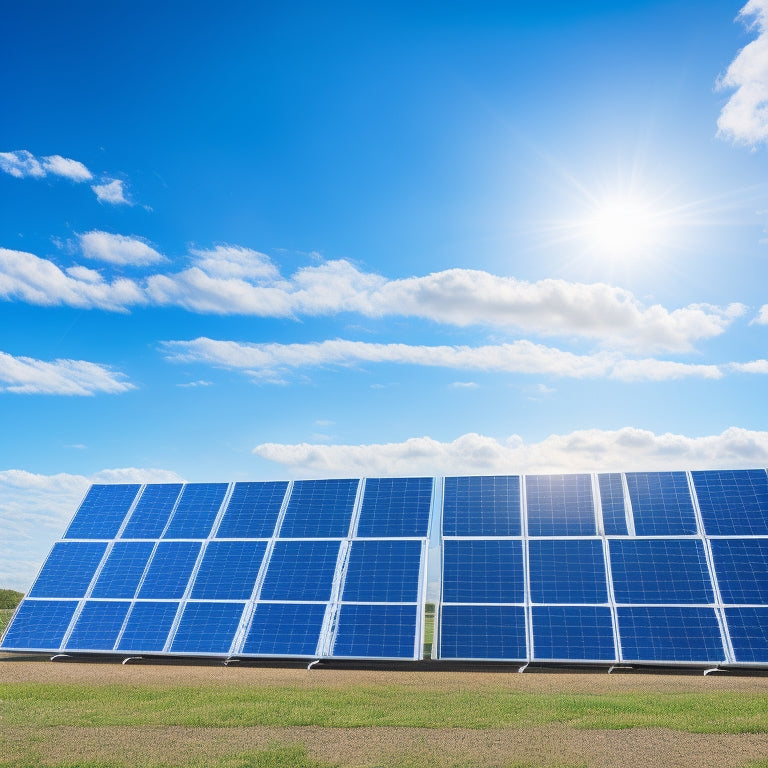
Optimizing Solar Panel Systems With Energy Storage
Share
When integrating energy storage with your solar panel system, you can optimize your energy usage by up to 30%. To achieve this, you'll need to correctly size your solar panel system, select the right energy storage technology, and implement a robust monitoring and control strategy. This involves conducting energy forecasting, analyzing energy consumption habits, and performing load profiling to determine your energy storage needs. By following these steps, you'll be able to maximize your energy independence and reduce your reliance on the grid. Now, discover the specific strategies and considerations necessary to harness the full potential of your solar panel system.
Key Takeaways
• Conduct energy forecasting and load profiling to determine optimal energy storage needs and solar panel system sizing.
• Select the right battery type and configuration based on cell chemistry, ensuring proper thermal management and operation within ideal temperature ranges.
• Implement a robust monitoring and control system with real-time analytics to maximize energy harvest and detect potential issues before they escalate.
• Optimize energy efficiency by enhancing panel angles, reducing wiring losses, and using high-efficiency inverters to minimize energy losses and maximize energy harvest.
• Integrate energy storage with solar panel systems to access additional grid services, backup power capabilities, and participate in community microgrids.
Understanding Energy Storage Needs
When designing an optimized solar panel system, you need to accurately assess your energy storage needs, as they directly impact the system's overall efficiency and reliability. To do this, you'll need to conduct energy forecasting, which involves analyzing your energy usage patterns to determine your daily energy requirements.
This involves collecting data on your energy consumption habits, including peak usage times and periods of low energy demand.
Load profiling is another critical step in understanding your energy storage needs. By creating a detailed profile of your energy usage patterns, you can identify areas where energy storage can be optimized.
This involves breaking down your energy usage into different load categories, such as essential and non-essential loads, to determine which appliances and devices require the most energy.
Solar Panel System Sizing
You'll need to size your solar panel system to guarantee it can meet your energy demands, taking into account your energy storage needs and the local solar irradiance. This involves calculating the required system capacity, which depends on factors such as your energy usage patterns, roof size, and available space for panel installation.
To optimize system performance, you'll need to take into account panel orientation, which greatly impacts energy output. Ideally, panels should face south (in the northern hemisphere) and be tilted at an angle equal to your latitude. This orientation guarantees maximum energy absorption throughout the day.
System scalability is also important, as it allows you to expand your system as your energy needs grow. When selecting a system, look for modular designs that enable easy upgrades and additions. This flexibility will save you time and money in the long run, ensuring your system remains efficient and effective.
Energy Storage System Types
As you explore energy storage options, you'll encounter various types of systems designed to optimize your solar panel system's performance.
You'll need to evaluate the pros and cons of different battery technologies, including battery energy storage, lead-acid battery systems, and lithium-ion battery options.
Battery Energy Storage
What sets battery energy storage apart from other energy storage system types is its ability to provide flexible, scalable, and responsive power backup solutions for solar panel systems.
As you explore battery energy storage, you'll find that it offers a range of benefits that make it an attractive option for optimizing your solar panel system. One significant advantage is the potential for cost savings. By storing excess energy generated during the day for use during periods of low sunlight or at night, you can reduce your reliance on the grid and lower your energy bills.
Additionally, battery energy storage systems require effective thermal management to guarantee peak performance and longevity. This involves maintaining a stable temperature range to prevent overheating, which can degrade the batteries over time. By incorporating thermal management strategies, such as cooling systems or temperature monitoring, you can maximize the lifespan of your battery energy storage system and ensure it operates at its best.
Lead-Acid Battery Systems
When selecting a battery energy storage system, lead-acid battery systems emerge as a viable option, offering a cost-effective and well-established technology for optimizing your solar panel system's performance. As a reliable and widely used energy storage solution, lead-acid batteries have undergone extensive testing and analysis to guarantee their reliability and efficiency.
| Parameter | Value | Description |
|---|---|---|
| Cycle Life | 500-1000 cycles | Measures the battery's lifespan based on the number of charge/discharge cycles |
| Deep Discharge | 50-80% DOD | Analyzes the battery's performance under deep discharge conditions |
| Efficiency | 80-90% | Represents the ratio of output energy to input energy |
Lead-acid batteries have undergone rigorous cycle life testing, which involves simulating real-world usage scenarios to determine their lifespan. Additionally, deep discharge analysis has been conducted to assess their performance under extreme conditions. With their proven track record and affordable pricing, lead-acid battery systems are an attractive option for optimizing your solar panel system's performance. By understanding the technical specifications and capabilities of lead-acid batteries, you can make an informed decision about integrating them into your energy storage system.
Lithium-Ion Battery Options
You can opt for lithium-ion battery options, which offer higher energy density and longer lifetimes compared to lead-acid batteries, making them a popular choice for energy storage systems. Lithium-ion batteries are well-suited for solar panel systems, as they provide a high discharge rate and efficient charging. Their high energy density enables them to store more energy per unit of weight and volume, making them ideal for applications where space is limited.
One of the key benefits of lithium-ion batteries is their durability. They can last for up to 5,000 charge cycles, compared to the 200-300 cycles of lead-acid batteries. This extended lifespan reduces the need for frequent replacements, resulting in lower Lithium Costs over time.
Additionally, lithium-ion batteries require minimal maintenance, as they don't need to be equalized or refilled with water. Overall, lithium-ion batteries offer a reliable and efficient energy storage solution for your solar panel system, providing a high level of Battery Durability and performance.
Battery Selection and Configuration
By carefully selecting and configuring the right battery type and size for your solar panel system, you can greatly enhance its overall performance and efficiency. When it comes to battery selection, cell chemistry plays an essential role. Lithium-ion batteries, for instance, are popular for their high energy density and long cycle life, making them an excellent choice for solar panel systems. However, you should also take into account other chemistries, such as lead-acid or nickel-cadmium, depending on your specific needs and budget.
Thermal management is another critical aspect to take into account during battery configuration. Operating temperatures can have a significant impact on battery performance and lifespan. Make sure that your battery system is designed to operate within the ideal temperature range, typically between 20°C to 30°C, to maximize its performance and longevity. Proper thermal management can be achieved through active cooling or passive cooling systems, depending on your system's requirements.
System Monitoring and Control
With your energy storage system optimized, it's now important to implement a robust system monitoring and control system to guarantee seamless integration with your solar panel system. This is essential to make sure that your system operates at peak performance and efficiency.
You need a monitoring system that provides real-time analytics, allowing you to track your energy production, consumption, and storage levels. This will enable you to identify areas of improvement and make data-driven decisions to optimize your system.
Automated alerting is also vital, as it will notify you of any system malfunctions or anomalies, allowing you to take prompt corrective action. A detailed monitoring and control system will give you complete visibility into your system's performance, enabling you to maximize your energy harvest and reduce losses.
Energy Efficiency Optimization
Maximizing energy efficiency is crucial to minimize energy losses and enhance the overall performance of your solar panel system. Even small improvements can significantly impact your energy harvest and savings. When it comes to energy efficiency optimization, every detail matters. You'll want to make certain that your system is designed and installed to minimize energy losses. This can be achieved through enhancing panel angles, reducing wiring losses, or using high-efficiency inverters.
In smart homes and green buildings, energy efficiency plays a vital role in reducing energy consumption and minimizing your carbon footprint. By optimizing your solar panel system, you can boost your energy harvest and decrease your reliance on the grid. This not only helps you save money on your energy bills but also contributes to reducing your environmental impact.
To achieve peak energy efficiency, it's crucial to take into account factors such as system design, component selection, and installation quality. By adopting a comprehensive approach to energy efficiency optimization, you can ensure that your solar panel system operates at its best, providing you with maximum energy savings and a reduced carbon footprint.
Load Shifting and Peak Shaving
You can greatly reduce your energy costs and alleviate strain on the grid by implementing load shifting and peak shaving strategies, which involve adjusting your energy usage patterns to minimize consumption during peak hours. By doing so, you can take advantage of Time of Use (TOU) rates, which offer lower energy prices during off-peak hours.
This approach allows you to shift non-essential loads, such as laundry or dishwashing, to nighttime or early morning hours when energy rates are lower.
Demand Response programs also play an essential role in load shifting and peak shaving. These programs incentivize you to reduce energy consumption during peak periods, usually in exchange for rebates or discounts. By participating in Demand Response programs, you can further optimize your energy usage and reduce your energy bills.
Grid Services and Backup Power
By integrating energy storage with solar panel systems, homeowners and businesses can access additional grid services and backup power capabilities, enhancing their overall energy resilience. This integration enables you to provide grid services such as frequency regulation, voltage support, and spinning reserve, which can generate revenue through demand response programs. Additionally, energy storage systems can provide backup power during grid outages, ensuring that critical loads remain operational.
| Grid Service | Description |
|---|---|
| Frequency Regulation | Regulate grid frequency by charging/discharging energy storage |
| Voltage Support | Provide reactive power to support grid voltage |
| Spinning Reserve | Offer backup power to the grid during outages |
| Backup Power | Provide power to critical loads during grid outages |
With energy storage, you can also participate in community microgrids, enhancing grid resiliency and providing backup power to your community during outages. This integration also enables you to sell excess energy back to the grid, further increasing your energy independence. By optimizing your solar panel system with energy storage, you can access additional revenue streams and improve your overall energy resilience.
System Maintenance and Upgrades
As you optimize your solar panel system with energy storage, you'll want to prioritize regular system checks to guarantee peak performance and identify potential issues before they escalate.
You'll also need to keep a close eye on your battery's health, monitoring its state of charge, voltage, and temperature to prevent degradation.
Regular System Checks
Regularly scheduled system checks are essential to ensuring peak performance of your solar panel system, identifying potential issues before they escalate into major problems. As a solar panel system owner, it's important to prioritize preventive maintenance to maximize energy output and reduce downtime.
Here are three key aspects to focus on during your regular system checks:
-
Visual Inspection:
Perform a visual examination of the solar panels, inverters, and cabling to identify signs of wear, damage, or corrosion. -
Performance Analysis:
Monitor your system's energy output and compare it to its expected performance. This helps detect potential issues before they become major problems. -
Data Review:
Review your system's data logs to identify trends, anomalies, or irregularities that may indicate potential issues.
Battery Health Monitoring
Monitor your energy storage system's battery health regularly to prevent unexpected downtime and optimize overall system performance. You can't afford to wait until it's too late, as neglected batteries can lead to reduced capacity, decreased efficiency, and even complete system failure.
Regular battery health monitoring enables you to identify potential issues before they escalate, ensuring your system operates at peak performance.
Track your battery's state of charge, voltage, and temperature to gain valuable insights into its condition. State estimation techniques, such as Coulomb counting or open-circuit voltage methods, can help you accurately determine your battery's state of charge.
This data enables you to adjust your system's configuration to maximize cycle life, reduce degradation, and prevent overcharge or undercharge.
Frequently Asked Questions
How Do I Ensure My Energy Storage System Is Compatible With My Solar Panel System?
'For compatibility assurance, you'll need to take into account system integration, battery sizing, and panel configuration. Verify inverter compatibility and conduct energy audits to guarantee smooth operation and maximum energy harvesting from your solar panel system.'
Can I Use My Energy Storage System to Power My Home During Outages?
You can leverage your energy storage system to provide backup power during outages, achieving grid independence and ensuring your home remains powered when the grid goes down, giving you peace of mind and energy autonomy.
Are Energy Storage Systems Safe and Reliable for Residential Use?
You're right to wonder about safety and reliability; energy storage systems are designed to minimize fire hazards through protective casing and cooling systems, and their battery durability is guaranteed through rigorous testing and certification.
How Often Should I Inspect and Maintain My Energy Storage System?
You should inspect your energy storage system every 3-6 months, tracking battery health and cycle count to guarantee peak performance, and perform maintenance tasks, like updating firmware and cleaning terminals, to prevent degradation.
Can I Monitor My Energy Storage System Remotely Through an App or Online Portal?
You can remotely monitor your energy storage system through a dedicated app or online portal, accessing real-time tracking and data analytics to optimize performance, identify potential issues, and receive alerts and notifications.
Related Posts
-

5 Key Components of EV Charging Infrastructure
When building an EV charging infrastructure, you'll need to focus on five key components. First, a reliable power dis...
-

7 Best Financial Incentives for Residential Homeowners
You're entitled to a range of financial incentives that can help offset the costs of owning a home, from federal tax ...
-

Designing Efficient Vehicle Charging Infrastructure Systems
As you design efficient vehicle charging infrastructure systems, prioritize strategic planning and optimization to av...


